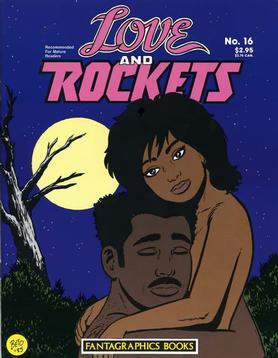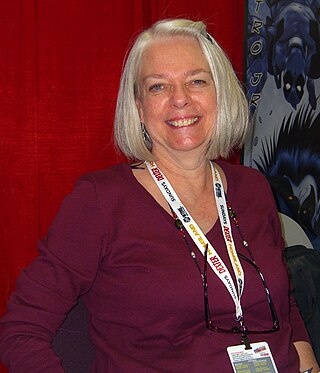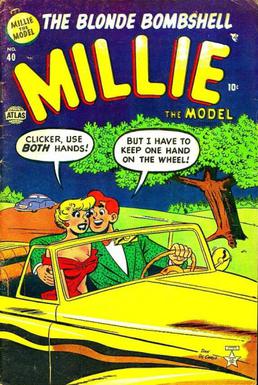
Christopher S. Claremont is a British-born American comic book writer and novelist, known for his 16-year stint on Uncanny X-Men from 1975 to 1991, far longer than that of any other writer, during which he is credited with developing strong female characters as well as introducing complex literary themes into superhero narratives, turning the once underachieving comic into one of Marvel's most popular series.

Gilberto Hernández, usually credited as Gilbert Hernandez and also by the nickname Beto, is an American cartoonist. He is best known for his Palomar/Heartbreak Soup stories in Love and Rockets, an alternative comic book he shared with his brothers Jaime and Mario.

Fantagraphics is an American publisher of alternative comics, classic comic strip anthologies, manga, magazines, graphic novels, and the erotic Eros Comix imprint.

Love and Rockets is a comic book series by the Hernandez brothers: Gilbert, Jaime, and Mario. It was one of the first comic books in the alternative comics movement of the 1980s.

Sheena, Queen of the Jungle, is a fictional American comic book jungle girl heroine, originally published primarily by Fiction House during the Golden Age of Comic Books. She was the first female comic book character with her own title, with her 1941 premiere issue preceding Wonder Woman #1. Sheena inspired a wealth of similar comic book jungle queens. She was predated in literature by Rima, the Jungle Girl, introduced in the 1904 William Henry Hudson novel Green Mansions.

JaimeHernandez is the co-creator of the alternative comic book Love and Rockets with his brothers Gilbert and Mario.

Louise Simonson is an American comic book writer and editor. She is best known for her work on comic book titles such as Conan the Barbarian, Power Pack, X-Factor, New Mutants, Superman: The Man of Steel, and Steel. She is often referred to by the nickname "Weezie". Among the comic characters she co-created are Cable, Steel, Power Pack, Rictor, Doomsday and the X-Men villain Apocalypse.

Millie the Model was Marvel Comics' longest-running humor title, first published by the company's 1940s predecessor, Timely Comics, and continuing through its 1950s forerunner, Atlas Comics, to 1970s Marvel. The comic book series deals with Millie Collins, an aspiring model.

Lady Luck is an American comic-strip and comic book crime fighter and adventuress created and designed in 1940 by Will Eisner with artist Chuck Mazoujian. She starred in a namesake, four-page weekly feature published in a Sunday newspaper comics insert colloquially called "The Spirit Section", which ran from June 2, 1940, to November 3, 1946. Her adventures were reprinted in comic books published by Quality Comics. A revamped version of the character debuted in 2013 in DC Comics's Phantom Stranger comic.

The Blonde Phantom is a fictional masked crime fighter appearing in American comic books published by Marvel Comics. Created for Marvel predecessor Timely Comics by Stan Lee and Syd Shores, the character first appeared in All Select Comics #11, during the 1940s period fans and historians call the Golden Age of Comic Books. The heroine was so well received that the next issue was retitled The Blonde Phantom. The series continued to feature her until issue #22. She also appeared in backup stories in many other Timely comics; in Superhero Comics of the Golden Age, Mike Benton observes that "for a few months in 1948, readers could find her in seven titles on the newsstand." In The Supergirls, Mike Madrid asserted, "Once again, a capable woman hid behind a meek persona and only let her hair down, literally, to come to the aid of a man who completely ignored her unless she assumed a disguise. In a 1947 story entitled "I Hate Myself", Louise even dreams that Mark finally confesses his love for her, only to have the Blonde Phantom persona appear and steal him away."

Katy Keene is a character created by Bill Woggon that has appeared in several comic book series published by Archie Comics since 1945. She is a model/actress/singer marketed by the publisher as "America's Queen of Pin-Ups and Fashions". In the book From Girls to Grrrlz: A History of Women's Comics from Teens to Zines by Trina Robbins, Katy Keene is called a Bettie Page look-alike. "... but the resemblance ended there.
The portrayal of women inAmerican comic books has often been the subject of controversy since the medium's beginning. Critics have noted the roles of women as both supporting characters and lead characters are substantially more subjected to gender stereotypes, with femininity and/or sexual characteristics having a larger presence in their overall character.

Rulah, Jungle Goddess is a fictional character, a jungle girl, in comic books published by Fox Feature Syndicate. She first appeared in Zoot Comics #7. Matt Baker designed her, before Jack Kamen and Graham Ingels helped develop her image.

Torchy is a comic strip and, primarily, a series of comic books featuring the ingenue Torchy Todd, created by the American "good girl art" cartoonist Bill Ward during 1944. The character was ranked 97th of the 2011 Comics Buyer's Guide's "100 Sexiest Women in Comics" list.
Mario Hernandez is an American writer, artist, and sometime publisher of comics. He is one of the Hernandez brothers, along with his younger brothers Gilbert and Jaime, with whom he co-created the acclaimed independent comic book Love and Rockets.

Poison River is a graphic novel by American cartoonist Gilbert Hernandez, published in 1994 after serialization from 1989 to 1993 in the comic book Love and Rockets. The story follows the life of the character Luba from her birth until her arrival in Palomar, the fictional Central American village in which most of Hernandez's stories in Love and Rockets take place.

The Hernandez brothers, also known as Los Bros Hernandez, are the three American cartoonist brothers Mario (b. 1953), Gilbert (b. 1957), and Jaime Hernandez (b. 1959).
Human Diastrophism, also known as Blood of Palomar, is a graphic novel by American cartoonist Gilbert Hernandez. It appeared in serialized form in the comic book Love and Rockets in 1987–88, and it first appeared in collected form in 1989 in The Complete Love and Rockets, Volume 8: Blood of Palomar. The story tells of a serial killer in the fictional Latin American village of Palomar, and the political and social implications of the insular villagers' growing contact with the outside world.
Wig Wam Bam is a graphic novel by Jaime Hernandez, serialized in Love and Rockets in 1990–93 and collected in 1994.

Love and Rockets X is a graphic novel by American cartoonist Gilbert Hernandez. Its serialization ran in the comic book Love and Rockets Vol. 1 #31–39 from 1989 to 1992, and the first collected edition appeared in 1993.














